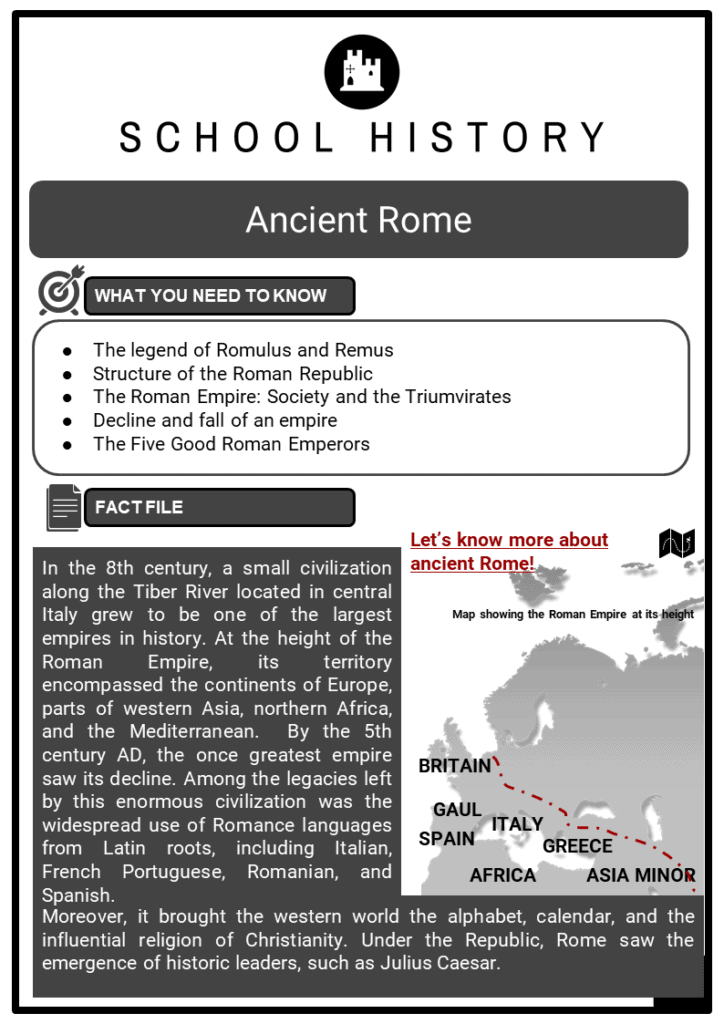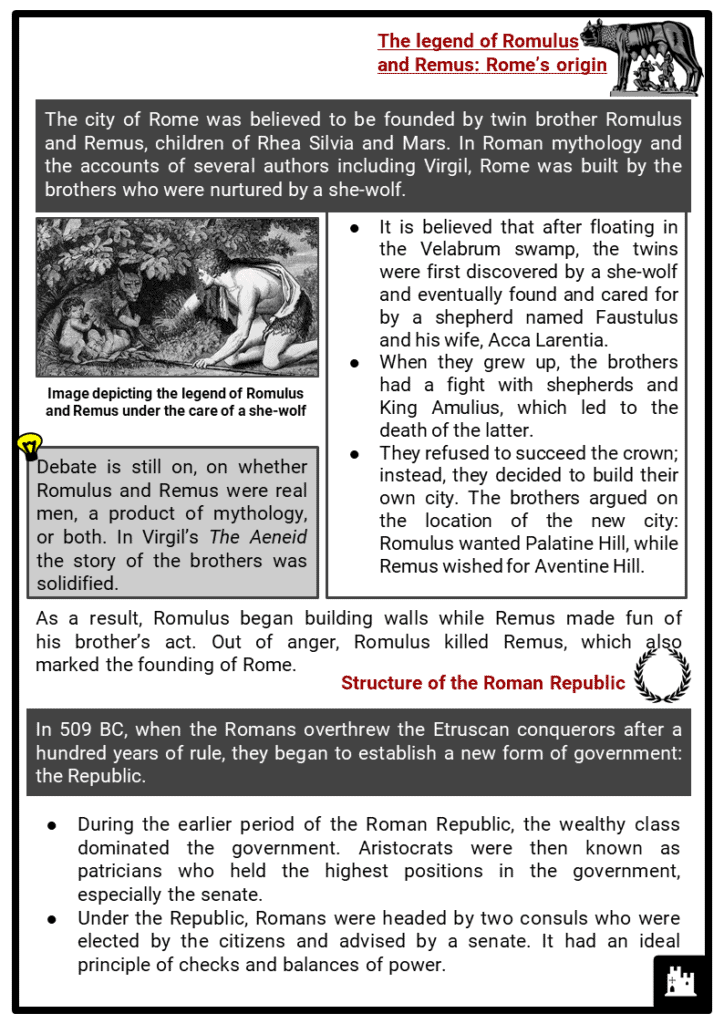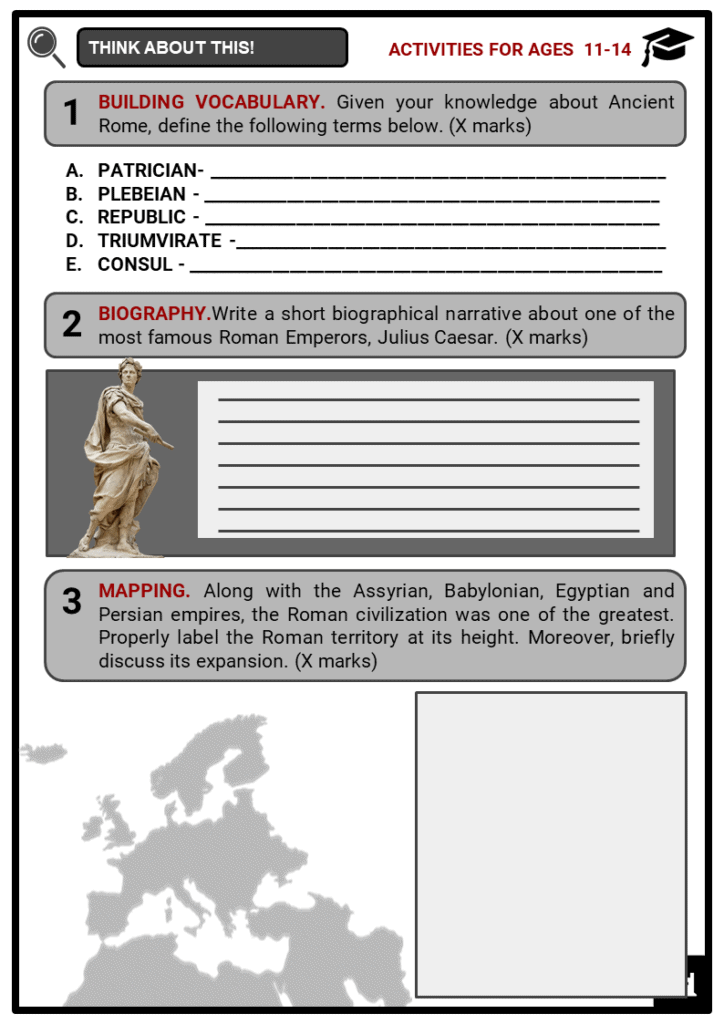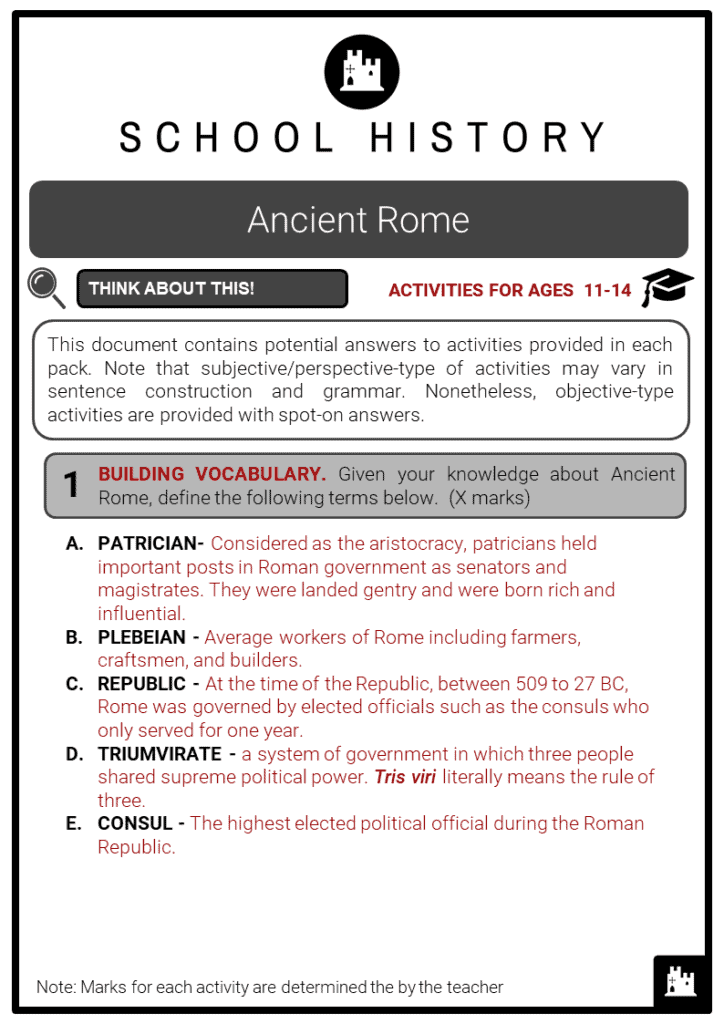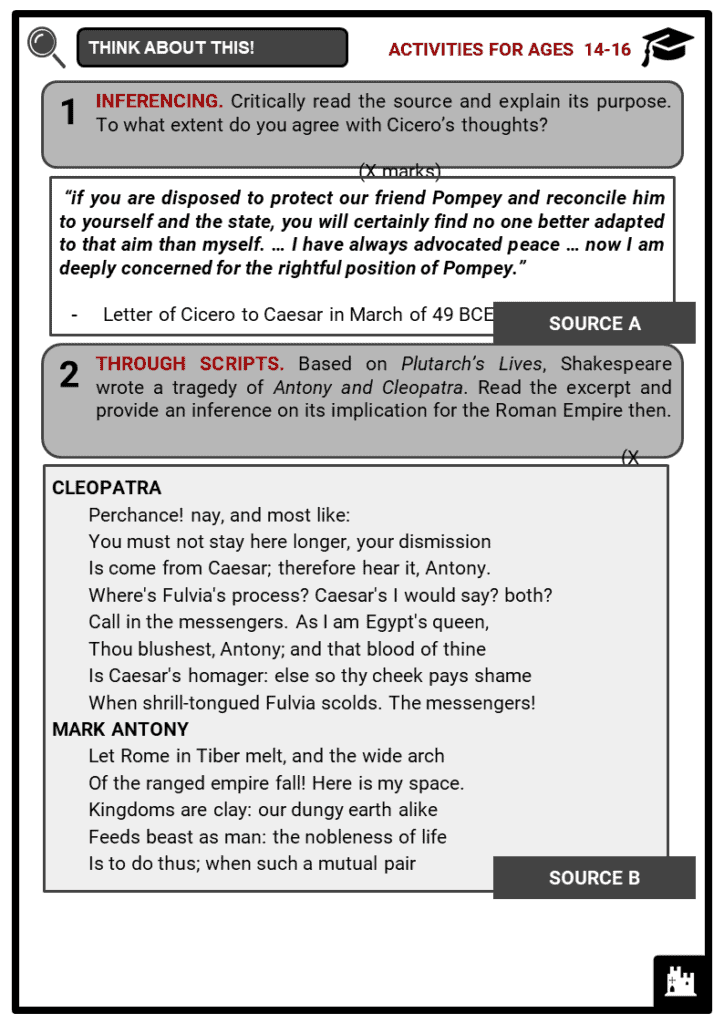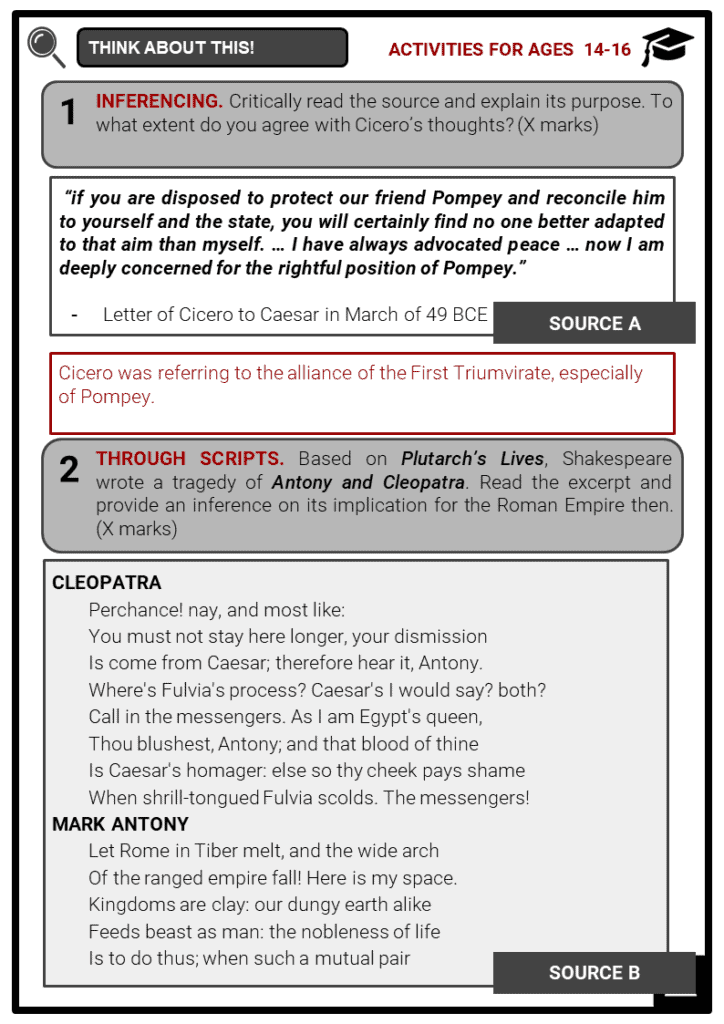Download Ancient Rome Worksheets
Do you want to save dozens of hours in time? Get your evenings and weekends back? Be able to teach Ancient Rome to your students?
Our worksheet bundle includes a fact file and printable worksheets and student activities. Perfect for both the classroom and homeschooling!
Table of Contents
Add a header to begin generating the table of contents
Summary
- The legend of Romulus and Remus
- Structure of the Roman Republic
- The Roman Empire: Society and the Triumvirates
- Decline and fall of an empire
- The Five Good Roman Emperors
Key Facts And Information
Let’s know more about Ancient Rome!
- In the 8th century, a small civilisation along the Tiber River located in central Italy grew to be one of the largest empires in history. At the height of the Roman Empire, its territory encompassed the continents of Europe, parts of western Asia, northern Africa, and the Mediterranean. By the 5th century CE, the once greatest empire saw its decline. Among the legacies left by this enormous civilisation was the widespread use of Romance languages from Latin roots, including Italian, French Portuguese, Romanian, and Spanish.
- Moreover, it brought the Western world the alphabet, calendar, and the influential religion of Christianity. Under the Republic, Rome saw the emergence of historic leaders, such as Julius Caesar.
The legend of Romulus and Remus: Rome’s origin
- The city of Rome was believed to be founded by twin brother Romulus and Remus, children of Rhea Silvia and Mars. In Roman mythology and the accounts of several authors including Virgil, Rome was built by the brothers who were nurtured by a she-wolf.
- It is believed that after floating in the Velabrum swamp, the twins were first discovered by a she-wolf and eventually found and cared for by a shepherd named Faustulus and his wife, Acca Larentia.
- When they grew up, the brothers had a fight with shepherds and King Amulius, which led to the death of the latter.
- They refused to succeed the crown; instead, they decided to build their own city. The brothers argued on the location of the new city: Romulus wanted Palatine Hill, while Remus wished for Aventine Hill.
- Debate is still on, on whether Romulus and Remus were real men, a product of mythology, or both. In Virgil’s The Aeneid the story of the brothers was solidified.
- As a result, Romulus began building walls while Remus made fun of his brother’s act. Out of anger, Romulus killed Remus, which also marked the founding of Rome.
Structure of the Roman Republic
- In 509 BCE, when the Romans overthrew the Etruscan conquerors after a hundred years of rule, they began to establish a new form of government: the Republic.
- During the earlier period of the Roman Republic, the wealthy class dominated the government. Aristocrats were then known as patricians who held the highest positions in the government, especially the senate.
- Under the Republic, Romans were headed by two consuls who were elected by the citizens and advised by a senate. It had an ideal principle of checks and balances of power.
- While the patricians were the wealthy ones, lower-class citizens were called plebeians, who had no say in the government. Men and women were regarded as citizens, however, only men could vote.
- Patricians could vote representatives into the senate, while the plebeians could elect their representatives called tribunes, who could veto laws passed by the senate during the latter years of the Republic.
- Like other ancient civilisations, patricians and plebeians were strictly separated as social classes. Marriage between different social classes was prohibited.
- Over time, the plebeians began to gain more power in the government, like holding the position of the consul. In times of emergency, such as war, the senate and the consuls had the power to appoint a dictator until the crisis was resolved.
The Roman Empire: Society and the Triumvirates
The First Triumvirate
- At the time of the Republic, between 509 to 27 BCE, Rome was governed by elected officials such as the consuls who only served for one year. This measure kept an individual from gaining too much power.
- The alliance between the three titans: Julius Caesar, Pompey, and Crassus formed the First Triumvirate, which lasted from 60 BCE until 53 BCE.
- In 70 BCE, Pompey and Crassus served as co-consuls of Rome, and later developed an intense rivalry.
POMPEY
- In 62 BCE, Pompey returned to Rome fighting the Mithridates, and the Senate feared that his army would take control of the city. Contrary to the Senate’s assumptions, Pompey returned as a citizen and disbanded his army. However, he demanded two things from the Senate: (1) he requested his men be granted land, and (2) he asked to ratify his settlement of the east. Both of Pompey’s requests were rejected by the Senate led by Lucullus.
- At the time of the Republic, between 509 to 27 BCE, Rome was governed by elected officials such as the consuls who only served for one year. This measure kept an individual from gaining too much power.
CRASSUS
- As one of the wealthiest citizens of Rome, Crassus served in the highest offices of the Roman Republic, namely the offices of consul and censor. He came from a prominent family of senators and orators. Crassus had great influence in Rome. Crassus emerged in politics after Sulla won the civil war against Marius. He used his wealth to gain a political following by financing campaigns, specifically that of Julius Caesar.
- Unlike the charismatic Pompey and Caesar, Crassus was less appealing to the people of Rome.
CAESAR
- Unlike the other two, Caesar was not prosperous. He returned to Rome a military hero aiming to gain wealth and fame. In order to seal an alliance, he married Pompey’s daughter, Julia. By 59 BCE, he became consul along with Bibulus. Caesar was unable to push Pompey’s reforms through the Senate because of opposition from Bibulus. Instead, he opted for the popular assembly, which later threw out Bibulus resulting in Caesar’s sole takeover of consulship. As a result, the veterans received land.
- Pompey’s jealousy and Caesar’s desire to return to consulship led to a civil war, the end of the triumvirate, death, and the dictatorship of Rome.
- In 50 BCE, after Caesar’s consulship, he and his army spent the next ten years in a campaign that would later gain Italy.
- As dictator, Caesar had the following rights:
- Supreme law of war and peace
- Nomination of magistrates
- Head of Roman religion
- Control of the treasury
- He also increased the number of Senators to 900
The Second Triumvirate
- On the Ides of March 44 BCE, Caesar was assassinated by a number of conspirators including Gaius Longinus, Marcus Brutus, and Decimus Brutus. The dictator for life was brutally stabbed by daggers in front of Pompey’s statue.
- The reason behind Caesar’s murder was the aim of a few to resurrect the old Roman Republic. However, after the assassination, the conspirators received a negative reception from the people, and they had to escape to the east.
- The new triumvirate, composed of Mark Antony, Lepidus, and Octavian, aimed to avenge the death of Caesar and stabilise the Roman Republic. However, like the First Triumvirate, their differences and desire for power soon clashed and eventually led to battle.
- In October of 43 BCE, the three met near Bononia and formed a Constitutional Commission in which the power share was similar to that of a consul.
- Gaius Julius Caesar Octavianus, one of the triumvirate, was the grand-nephew and adopted son of Caesar.
- In November of 43 BCE, the new triumvirate was officially recognised by the Senate. They were granted supreme authority for five years.
- The Second Triumvirate lasted for two terms, from 43 BCE to 33 BCE.
- Among the first tasks was to hunt down Caesar’s conspirators, especially Brutus and Cassius. Soon, a public decree was issued condemning 300 Senators and over 2,000 Roman equites, or knights.
- Cicero, a prominent orator, was among those executed after condemning Mark Antony in one of his writings.
MARK ANTONY
- Born a patrician, Mark Antony became Caesar’s right-hand-man at the age of 54. Both served in Gaul and, in Caesar’s absence, Mark Antony took over as administrator. He gave a funeral oration for Caesar and used it to hunt down the assassins. At the Battle of Actium, Mark Antony and Cleopatra were defeated by Octavia.
- Mark Antony married Octavian’s sister, Octavia, but became despised by his co-consul after his relationship with Egypt’s Cleopatra and his favour for Egypt over Rome.
- Triumvirate is a system of government in which three people share supreme political power. Tris viri literally means the rule of three.
- Compared to the First Triumvirate who power grabbed authority, the Second Triumvirate was recognised by the Senate as legitimate power.
OCTAVIAN
- As Caesar’s nephew, Octavian had a rightful claim to power but lacked military forces. As a result, he made an alliance with Mark Antony and Lepidus, who both had influence in the Senate and the military. With the fall of the triumvirate, Octavian became the victor and was later named Augustus, the first emperor of Rome.
MARCUS LEPIDUS
- Born in 89 BCE, Lepidus was named by Caesar as the ‘Master of the Horse’ in 44 BCE. He served as praetor in 49 BCE, and Consul in 46 BCE. A patrician and former Senator, he served as deputy dictator under Caesar.
- When Lepidus attempted to seize control of Sicily, he was faced by Octavian. The army of the former sided with Octavian, leaving Lepidus without an army.
- As a result, Lepidus was forced into exile, and the triumvirate was left with Mark Antony and Octavian. Initially, the alliance with Mark Antony and Octavian was clear after the marriage of the latter’s sister.
- However, when Octavian discovered that Mark Antony was spending more time in Egypt with Cleopatra and that he favoured his family in Egypt over that in Rome in his will, he used this to manipulate the people of Rome against Antony.
- By the time the Second Triumvirate was formed, they had agreed to rule separate land: Lepidus ruled Hispania (Spain), Octavian took North Africa, and Mark Antony took Gaul (France).
- In 32 BCE, upon the discovery of Mark Antony’s will, the Final War of the Roman Republic was declared between Mark Antony and Octavian.
- The Roman Senate supported the war orchestrated by Octavian against Mark Antony and Egypt’s Cleopatra.
- Separated by the sea, Rome and Egypt had large naval battles. In the Battle of Actium, Octavian defeated Mark Antony.
- Cleopatra and Mark Antony retreated to Alexandria where they died shortly after.
- Upon his victory, Octavian was named as the sole Emperor of Rome with the title, Son of Caesar.
- The civil war between Mark Antony and Octavian was called The Final War of the Roman Republic because, afterwards, Rome became an Empire.
- Cleopatra was known for her intelligence and beauty. She was the last pharaoh of ancient Egypt. Prior to her love affair with Mark Antony, she had a son with Julius Caesar, named Caesarion or ‘Little Caesar.’
The Roman Society
- In general, Roman society was rigidly patriarchal and hierarchical. Romans were extremely bound by laws and higher authorities.
- Through time, especially under the empire, Romans developed a huge body of law governing their public and private life. Under Roman law, all citizens were guaranteed a fair trial. Several courts presided by magistrates dealt with both criminal and civil cases. Punishment was usually flogging, and execution for severe ones.
- Like the Republic, the Roman Empire had an enormous army, which was classified into legions and auxiliary cohorts. Legions served as the backbone of the empire since the Republic. They secured the frontiers of the empire from outside invasion. From 4,000 men before the Republic, the army increased to 6,000. A legionary was bound to serve in the legion for 21 years. Upon retirement, each received a lump sum of money.
- Inside the empire were praetorian guards, quasi-military urban cohorts, and the fire brigade, known as Vigiles. Most of the praetorian guards were recruited from the Danube provinces and served as centurions in the legion. They were classified as the elite troops of the empire.
- By the end of the Republic, slave-run estates began to diminish with the emergence of peace in the Mediterranean. As a result, the purchase of enslaved people became expensive, so enslavers tended to rely on natural reproduction. Among the consequences was the better treatment of enslaved people. Usually, enslaved people were tied to the estates as tenants and sharecroppers. Over the years, many enslaved people were given freedom and became a significant portion of the empire’s population.
- Among the free population were the peasants, middle class, and the rich. Peasants were usually farmers, labourers, and craftsmen. The middle class was composed of better-off peasant farmers who were able to own small pieces of land. Others were retired soldiers. The rich usually lived in cities as merchants, local magistrates, councillors, lawyers, and bankers, and many owned vast land.
- Like the Greeks, Romans practised a traditional religion that worshipped a pantheon of gods and goddesses.
- Many observed rituals and superstitious beliefs, like associating bad omens with one’s actions. Like the Greeks, they consulted famous oracles and priests.
- Massive buildings were built to honour Roman deities. For example, the Heliopolis, also known as Baalbek, was erected in northeastern Lebanon. For two centuries, the temples of Jupiter, Bacchus, and Venus were built here.
- Bacchus is also known as Dionysus, the Roman god of wine.
- Short list of major Roman gods and goddesses:
- Jupiter - chief of the gods
- Minerva - goddess of wisdom
- Mars - god of war
- Venus - goddess of love
- Ceres - goddess of Earth
- Pluto - god of the underworld
- In general, the Roman social class was divided into two: the upper class called the patricians, and the working class, the plebeians.
- Between 500 to 287 BCE, these classes often struggled due to laws favouring the higher class. By 494 BCE, the plebeians were able to speak their grievances through their own representatives in the Senate. The Conflict of Orders changed Roman law on social classes.
- During the earlier stage of the Roman Republic, women were regarded as non-citizens. They were their father’s and husband’s property. They began to gain more rights during the late stages of the Republic but remained under the control of patriarchs.
- As heads of families, fathers had complete control over their children until death. The father had the right to decide if a newborn would be kept in the house or abandoned in the streets, for whatever reason. Usually, more daughters were rejected than sons. These abandoned children were left in the streets and picked up by slave-traders who then raised and sold them to slavery.
- As subjects of their fathers and husbands, women were taught to run a household. By the late era of the Republic, they were granted the right to file for divorce, undergo abortions (with a man’s consent), and inherit and sell property. In the event of a divorce, women had no right over their children.
- As decided by their fathers, 12 was the legal age for a girl to be married. Most boys married between 15 and 26 years old. Given the patriarchal society, families focused on having sons. During the Republic, military service was compulsory for all men, which later became voluntary during the Empire.
Roman Architecture
- Partly influenced by Greek art, Roman architecture was one of the lasting legacies of this civilization. Moreover, Etruscan capabilities also contributed to Roman art in general. The Romans became known for the following:
- Built using arches, domes, vaults and buttresses, Roman baths were complexes with pools, cold and hot rooms, fountains, libraries, and under-floor and inter-wall heating.
- In 312, the Romans built Aqua Appia, their earliest aqueduct, which carried fresh water to urban centres from kilometres-away water sources.
- Prior to being used by the Christian church, basilicas were first built by the Romans as a place for large gatherings, such as law courts. An example is the Severan Basilica built in 216 CE.
- Inspired by the Greeks, theatres and amphitheatres were stage buildings for performances and gladiator tournaments. Among the largest and most famous was the Colosseum.
- Roman military victories were commemorated through triumphal arches built with a single, double, or triple entrance.
- Most were inscribed with significant events. In 315 CE, the Arch of Constantine was built, which became among the greatest monuments of the Empire.
- The Romans were known for building private homes decorated with fresco and stucco. Most elite residences had atriums, peristyles, gardens and fountains. For city-dwellers, homes were built from brick and concrete above shops. They sometimes had balconies.
- Built using a combination of the Etruscan and Greek models, Roman temples were buildings surrounded by columns and often placed above a platform. Temples were usually rectangular in shape, while others were circular or polygonal. An example is the Maison Carree at Nimes, built in 16 BCE.
Decline and fall of an empire
- From the time that Augustus Caesar ruled Rome as its first Emperor until its collapse in 476 BCE under Emperor Romulus Augustulus, the empire experienced the most extensive political and social structural shifts in the history of Western civilisation.
- Factors which led to the fall of the Roman Empire:
Outside invasion
- For centuries, Rome was defending itself from the invasion of Germanic tribes. However, in 410 BCE, King Alaric, the King of the Visigoths, successfully invaded the city of Rome. By 455, the city was sacked again by the Vandals, and finally by Germanic leader Odoacer, which deposed Emperor Romulus.
Division of the empire
- During the reign of Emperor Diocletian, Rome was divided into two: the Western Empire centred in Milan, and the Eastern Empire in Byzantium. Both empires failed to cooperate and work as one against outside invasion. With Constantinople secured with walls, the city of Rome was left vulnerable.
Reliance on slave labour
- One of the effects of attacks from barbarians was a financial crisis in Rome. As a result, oppressive taxes were imposed pushing wealthy classes to set up independent fiefdoms to escape payment. With a great labour deficit, many relied on slave labour, but it began to dry up, and the economy could not recover.
Military Overspending
- At its height, the Roman Empire governed vast territories that required protection. During Emperor Hadrian’s reign, most of the funds were allocated to building walls to keep outside invaders at bay. As the Empire spent on the military, technological advancement was neglected.
Weak Roman Legions
- At the time of Emperors Diocletian and Constantine, many of the Roman citizenry refused to conscript to the legion. As a result, the Empire began to hire foreign mercenaries to fill in the Roman army. Despite showing great military skills, mercenaries such as members of the Germanic tribes had no loyalty to Rome.
Rise of Christianity
- Many associate the rise of Christianity as one of the causes of Rome’s decline. In 380 CE, Christianity became the state religion and influenced Roman values and religion. Moreover, priests and Popes began to influence political affairs. The idea that the Emperor had the divine status to rule contributed further to the decay.
The Five Good Roman Emperors
- Though Julius Caesar was not an emperor, after his death, the title of Emperor of Rome was passed along both by inheritance and rebellion. For decades, such practice ruled the Roman Empire, until the assassination of Nero.
- NERVA. In 96 BCE, Nerva was the first Emperor to be chosen by the Senate. He ruled after the assassination of Domitian. Due to old age and lack of children, he chose his successor based on merit. Despite only ruling for a short period of time, he was known to have set the course of the empire.
- TRAJAN. In 98 BCE, Trajan began his rule as Emperor of Rome. He shared responsibilities of leadership with the Senate, which later named him as one of the most just emperors in Roman history. Equipped with military and civil leadership, Trajan expanded the borders of Rome to their peak. Massive infrastructure, including buildings, bridges, canals, and monuments, was built.
- HADRIAN. After the success of Trajan in expanding the Empire, Hadrian was able to turn territories into real political units. Among his legacies was the building of an extensive wall to protect the Empire from invaders. Amidst shrinking borders of the Empire, he was able to secure the remainder before his death. He named Antoninus Pius as his successor and Marcus Aurelius as his own successor in turn.
- ANTONINUS PIUS. As a skilled administrator, Antoninus Pius focused on economic and legal reforms. He made sure that laws were more equitable and fair to all citizens. Antoninus Pius became popular for his concept that a suspect is innocent until proven guilty. During his reign, he expanded the rights of slaves. Moreover, drastic changes in the legal system were made through several legal advisors and new laws.
- MARCUS AURELIUS. Among the five good emperors, Marcus Aurelius was the most famously philosophical. In 161 BCE, he became Emperor. He was known for being a skilled civil servant who focused on domestic affairs. Like Trajan, he consulted the Senate in decision-making. Written during the Germanic war, Aurelius was known for his book The Meditations, which tackles his Stoic philosophy on living a good life both as a citizen and as Emperor.
- The heirs of Augustus, Tiberius, Caligula, Claudius, and Nero succeeded him. Nero, the last of his dynasty, was defeated by Vespasian, a member of the Flavian dynasty. The Antonines followed, which included the Five Good Emperors.

